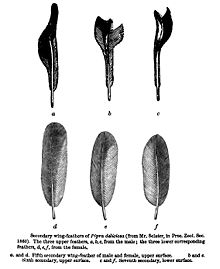From Wikipedia, the free encyclopedia
"Bird song" redirects here. For other uses, see Birdsong (disambiguation).

A male Blackbird (Turdus merula) singing. Bogense havn, Funen, Denmark.  Blackbird song recorded at Lille, France (help·info)
Blackbird song recorded at Lille, France (help·info)
Contents[hide] |
[edit] Definition

Wing feathers of a male Club-winged Manakin, with the modifications noted noted by P L Sclater in 1860[1] and discussed by Charles Darwin in 1871[2]
Bird song is best developed in the order Passeriformes. Most song is emitted by male rather than female birds. Song is usually delivered from prominent perches although some species may sing when flying. Some groups are nearly voiceless, producing only percussive and rhythmic sounds, such as the storks, which clatter their bills. In some manakins (Pipridae), the males have evolved several mechanisms for mechanical sound production, including mechanisms for stridulation not unlike those found in some insects.[5]
The production of sounds by mechanical means as opposed to the use of the syrinx has been termed variously instrumental music by Charles Darwin, mechanical sounds[6] and more recently sonation.[7] The term sonate has been defined as the act of producing non-vocal sounds that are intentionally modulated communicative signals, produced using non-syringeal structures such as the bill, wings, tail, feet and body feathers.[7]
No comments:
Post a Comment